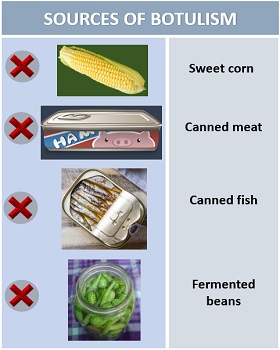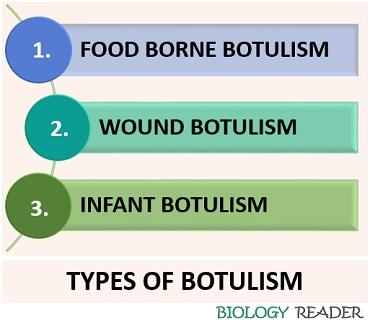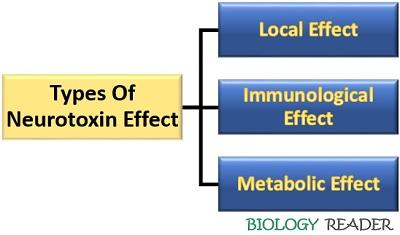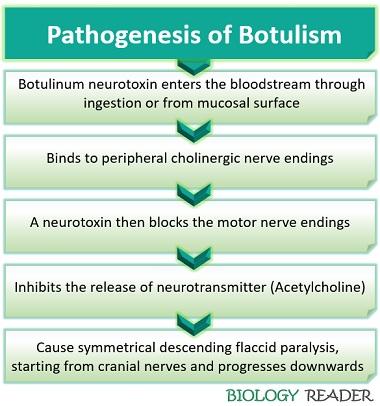Botulism disease is caused by a bacterial agent, Clostridium botulinum, that produces an exotoxin. Clostridium botulinum causes bacterial food poisoning or intoxication as it releases exotoxin. Exotoxin acts as a neurotoxin, which disables the normal functioning of the nervous system.
Thus, an exotoxin produced by Clostridium botulinum is called botulinum neurotoxin, which blocks the synthesis of the neurotransmitter acetylcholine from the cholinergic neurons. Botulism causes symmetrical descending flaccid paralysis. A paralysis first starts from the face and then disseminates towards the limbs.
Clostridium botulinum produces a “Neurotoxin”, which is considered one of the potent substances for human health. A case of botulism was first recorded in the year 1735 in the people who consumed German sausages. In 1870, a scientist named Muller named the disease “Botulus” (derived from the Latin word for sausage).
Content: Botulism Disease
- Definition
- Causes
- Food Sources
- Types
- Types of Neurotoxin Effects
- Symptoms of Botulism disease
- Pathogenesis
- Prevention
- Treatment
- Diagnosis
Definition of Botulism
Botulism refers to a clinical condition during which the neurotoxin of Clostridium botulinum paralyzes the involuntary muscles by inhibiting the motor nerve endings from synthesizing acetylcholine. Clostridium botulinum commonly releases neurotoxin (Botulinum neurotoxin), which accumulates in the small intestine. A botulinum neurotoxin mainly affects the nervous system and paralyzes the involuntary muscles of the body. Botulism can occur in both humans and animals.
Causes of Botulism
Botulism is caused by a neurotoxin produced by Clostridium botulinum. Neurotoxin is an exotoxin, which affects the nervous system. Botulism is a clinical condition, paralyzes the involuntary muscles and further spreads to the respiratory system and the heart. Based on serological specificity, neurotoxins are categorized into the following seven serological types:
- Type A: It is a type of human botulism, which is very common in the western regions of the United States.
- Type B: It is also a type of human botulism that occurs frequently, and it is less toxic than type-A.
- Type-C: It is not a type of human botulism and causes botulism in cattle, fowls etc.
- Type-D: It mostly causes forage poisoning of cattle in South African countries.
- Type-E: This type of neurotoxin is obtained chiefly from fish and fish products. Type-E is very toxic to humans.
- Type-F: It was first isolated in Denmark and is a type of human botulism.
- Type-G: This has been recently isolated from the soil in Argentina, and it is not a type of human botulism.
Food Sources
The spores of Clostridium botulinum sporulate to produce a neurotoxin, which can be present in the following food sources:

- Canned meat
- Canned fish
- Honey syrup
- Sweet corn
- Fermented beans
- Other low acid foods
Spores of Clostridium botulinum generally grows in favourable conditions like:
- Low acid
- Anaerobic environment
- Low sugar
- Low salt
- And low temperature.
Types of Botulism
There are three forms of botulism caused by Clostridium botulinum:

Foodborne botulism: It spreads by eating food contaminated with the spores produced by the Clostridium botulinum. Foodborne botulism develops after the consumption of unprocessed, undercooked, canned and unrefrigerated food.
- Symptoms include:
- Blurred vision
- Difficulty in swallowing
- Muscle weakness
- Dry mouth
- Nausea
- Vomiting
- Abdominal cramps
- Paralysis etc.
Wound botulism: It spreads when the spores of the bacteria (Clostridium botulinum) enters the body through a cut or any mechanical injuries. The spores of Clostridium botulinum sporulate to produce neurotoxin within the wound. The risk factors include people who are addicted to drugs like heroin.
- Symptoms include:
- Slurred speaking
- Double vision
- Drooping eyelids
- Paralysis etc.
Infant botulism: It spreads by the ingestion of the Clostridium botulinum spores that grow in the infant’s intestinal tract of age limit between 2-8 months. Infant botulism develops after the consumption of honey syrup.
- Symptoms include:
- Constipation
- Floppy movements
- Irritation
- Drooping eyelids
- Paralysis etc.
In addition to this, there are some other types also that occur very rarely. Adult botulism is rarely seen, in which the spores of the Clostridium botulinum colonize in the digestive tract of adults. Iatrogenic botulism is very lethal, which occurs by an overdose of botulinum neurotoxin or botox.
Types of Neurotoxin Effects
Botulinum neurotoxin can produce the following type of effects:

- Local effect: The local effects of Clostridium botulinum includes the following symptoms:
- Blurred vision
- Muscle weakness
- Dry mouth
- Reduced gag reflex etc.
- Immunological effect: It occurs by the administration of equine antitoxin.
- Metabolic effect: It is characterized by a symptom (respiratory acidosis).
Symptoms of Botulism disease
A neurotoxin produced by Clostridium botulinum can affect the cardiovascular, respiratory and central nervous system etc.
- Effect on the cardiovascular system: Botulinum neurotoxin blocks the automatic nervous system and leads to cause tachycardia and hypertension.
- On respiratory system: A neurotoxin paralyzes the respiratory muscle and results in ventilatory failure, and ultimately leads to death.
- Effect on the nervous system:
- Central nervous system: Botulinum neurotoxin paralyzes the cranial nerves and causes symptoms like:
- Blurred vision
- Diplopia
- Dysphonia
- Dysarthria
- Dysphagia etc.
- Peripheral nervous system: After paralyzing cranial nerves, botulinum neurotoxin causes symmetrical descending paralysis, affecting the respiratory muscles.
- Automatic nervous system: Botulinum neurotoxin blocks the autonomic cholinergic junctions and causes the following symptoms:
- Blurred vision
- Orthostatic hypotension
- Constipation
- Urinary retention etc.
- Central nervous system: Botulinum neurotoxin paralyzes the cranial nerves and causes symptoms like:
- Skeletal and smooth muscles: Botulinum neurotoxin affects the skeletal and smooth muscles by causing gallbladder dysfunction and necrotic fasciitis.
- Effect on Gastrointestinal system: A neurotoxin shows the gastrointestinal symptoms after 18-36 hours of incubation, and the symptoms include:
- Nausea
- Vomiting
- Abdominal cramps
- Diarrhoea
- It sometimes leads to cause constipation, gastric dilatation and paralytic ileus.
- Neurotoxin does not directly affect the hepatic system (liver) and the urinary bladder.
Pathogenesis
A neurotoxin produced by the Clostridium botulinum causes botulism by following a given pathogenic cycle:

- First, neurotoxin enters the bloodstream through the ingestion of the bacterial spores or from the mucosal surface.
- Botulinum neurotoxin blocks the nerve terminal ends.
- Then, it binds to the neuronal membrane.
- After that, a neurotoxin enters the cytoplasm of the axon terminal.
- Then, botulinum neurotoxin blocks the excitatory synaptic transmission and results in interference with the synthesis of neurotransmitter “Acetylcholine”.
- Finally, it causes flaccid paralysis, as the nervous system cannot function without the action of acetylcholine. Acetylcholine plays an essential role in producing nerve impulse and the process of muscle contraction.
Prognosis
There are many cases of botulism, and if it remains untreated, then the mortality rate reaches about 50-60%. Treated patients may also concur with botulism, with a mortality rate of about 3-5%. The diagnosis or treatment of botulism should be made early otherwise, it can cause major outbreaks.
Prevention
There are a few first aid measures that can control the transmission of the disease to some extent.
Foodborne botulism: To prevent its transmission
- Avoid eating canned food
- Properly wash and boil the vegetables before eating.
- Trash the canned food that is bulging or leaking.
- Avoid eating foods that are added with preservatives.
- Avoid eating undercooked food.
Wound botulism: To prevent its transmission
- Properly sanitize the wounded area.
- Maintain proper body hygiene.
- Do not let the wound open to the air, as the spores of Clostridium botulinum can penetrate inside the cells through any cuts or injuries.
Infant botulism: To prevent infant botulism, keep the body hygienic and don’t give corn or honey syrup to the infants.
Treatment
The early symptoms of botulism can be treated by the oral administration of polyvalent antitoxin. Enemas are found effective in the removal of the unabsorbed toxin.
Diagnosis
Diagnosis of botulism involves the following tests:
Mouse inoculation test: It is the most reliable and popular method to detect the presence of C.botulinum. Mouse inoculation test involves two series of tests. In one experiment, a patient’s stool is injected into the peritoneal cavity of mice. And, in the second test, an equal amount of the patient’s stool plus multivalent antitoxin is injected into the other mice.
If the mice live, by the injection of antitoxin and stool sample and die by the infusion of an untreated serum sample, then it gives a positive result for botulism. Mouse inoculation test detects the presence of particularly A, B and E serotypes of C. botulinum.
Physical tests: It includes tests like brain scan, spinal fluid examination, nerve conduction test (electromyography).